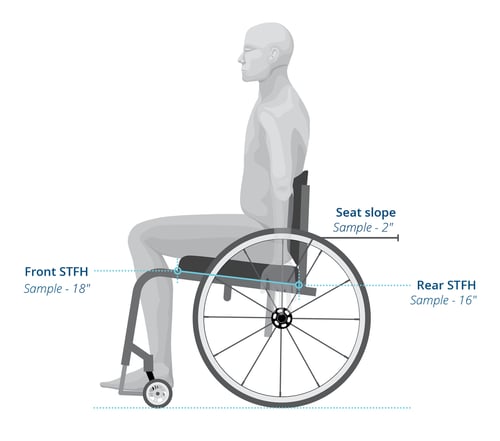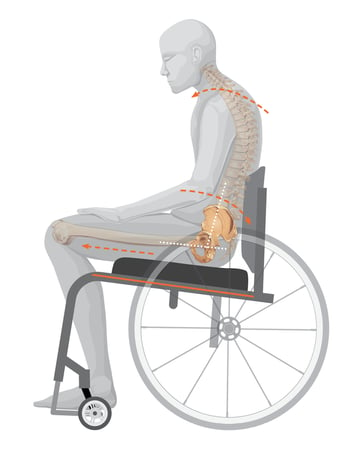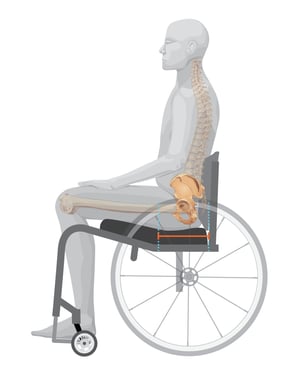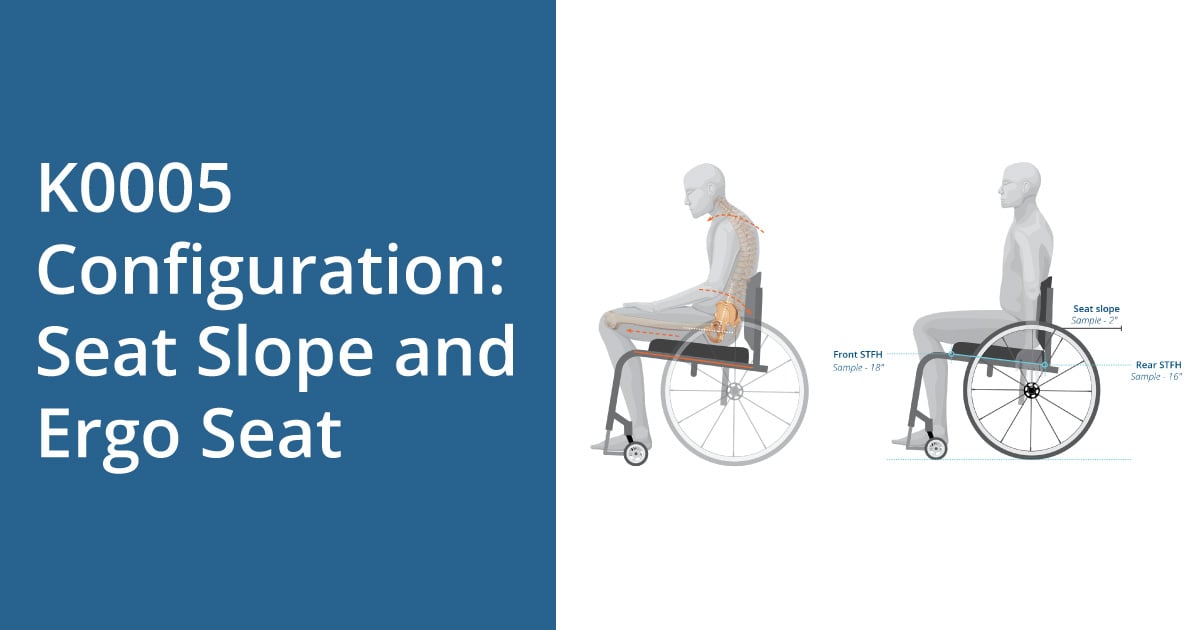This is the 6th blog in our manual wheelchair guide series. See the 1st blog, 2nd blog, 3rd blog, 4th blog, and 5th blog. Check out the Manual Wheelchair Guide to learn more.
We're continuing our conversation about configuring a K0005 wheelchair to an individual. Today we're looking at seat slope and ergo seat.
Seat Slope
 The seat slope is the difference between the front and rear STFH and is important for postural stability and optimal wheel access for propulsion.
The seat slope is the difference between the front and rear STFH and is important for postural stability and optimal wheel access for propulsion.
- An appropriate amount of seat slope from font to back provides gravity-assisted postural stability, especially important for those with decreased trunk control
- Consider available hip range of motion when determining seat slope
- Insufficient seat slope may make sitting up difficult while too much seat slope may make transfers more difficult
| * Most adults need about 2" seat slope if they propel with their UEs. Foot propellers need 1/2" to 1" seat slope. |
Utilizing an ergonomic (ergo) seat
Sometimes a conventional seat slope won’t work for these reasons:
- There is an insufficient range of motion (ROM) at the hip required for the slope
- The individual requires 3" or more seat slope for stability and rear wheel access With 3" or more of seat slope an acute hip-to-back angle is created so even a WC user with normal ROM will not be able to access/fit their hips into the rear potion of the seat
- Individual may feel unstable
- Individual complains of pain
- Individual complains of sliding forward

Complications of too much seat slope: If the seat-to-back angle of the chair is demanding more hip flexion than is available; OR, if the seat slope creates an acute back angle space that they cannot fit into, the individual will compensate with their spine and fall into a posterior tilt, sliding forward in the seat.
Ergo Seat
An ergonomic seat is intended to match an individual’s shape while providing a lower RSTFH relative to the front. The RSTFH is maintained for a specified length in which to seat the pelvis before of the frame before the seat tubing ascends up to the FSTFH specified.
- This promotes an upright posture by maintaining a more open STBA compared to a conventional seat slope
- It allows for better stability, positioning, and pressure distribution by creating a stable, neutral place to seat the pelvis and load the femurs
- Allows improved rear wheel access for more efficient propulsion
- It optimizes total surface contact area, increasing pressure redistribution for the bony prominences and encouraging pelvic stability
- The shape allows the thighs to be more level. It often results in greater functional activity and seating tolerance for the wheelchair user.
Ergo seat measurement

Anatomical measurement for the Ergo seat is from behind the hip to the greater trochanter, plus 1 - 2".
The measurement for the Ergo seat on the wheelchair is from is from the back post of the WC to the point in the tubing where you want it to start to bend upwardly.
| * Instability from an increased seat slope can be offset by using an ergo seat when clinically appropriate for the user. |
The idea is to contain the ITs within the flat ergo well. Since the frame is providing the positioning, the goals of the cushion need to be consistent with the goals of the wheelchair. The cushion needs to follow the contour of the frame and provide a flexible pressure relieving interface between the frame and the wheelchair user.

 Stacey Mullis, OTR/ATP
Stacey Mullis, OTR/ATP
Director of Clinical Marketing
Stacey serves as Director of Clinical Marketing for Permobil. A practicing OTR for over 20 years, she has experience in school-based pediatrics, inpatient rehabilitation, long term care, and home health. With her interest in wheelchair seating and positioning, Stacey engaged the challenges of providing appropriate seating in various clinical settings. She now uses this experience to develop programs and resources to educate clinicians on the principles of seating and wheeled mobility. She is passionate about equipping clinicians and through her previous role as Director of Clinical Education with Comfort Company and now with Permobil she has taught nationally and internationally to increase therapist capacity in this specialty area. Mullis graduated from Western University in London, Ontario, Canada with a BA Linguistics and BSc Occupational Therapy. She is a member of the NCOTA, CTF Executive Board, NRRTs, RESNA, and AOTA.
 Ginger Walls, PT, MS, NCS, ATP/SMS
Ginger Walls, PT, MS, NCS, ATP/SMS
Director of Clinical Sales and Education
Ginger has 25 years of experience as a physical therapist in the area of neuro rehab and wheelchair seating/mobility. She directed the Outpatient therapy clinics and the Seating/Mobility Program at Medstar National Rehabilitation Hospital in Washington, D.C. Additionally, Ginger has provided a variety of continuing education courses and lectures in the area of seating/mobility for many years. She has presented at major industry conferences including ISS, RESNA, and the PVA Summit. Ginger took on the role of Clinical Education Specialist for Permobil in 2015 and was appointed Director of Clinical Sales and Education in 2020.
